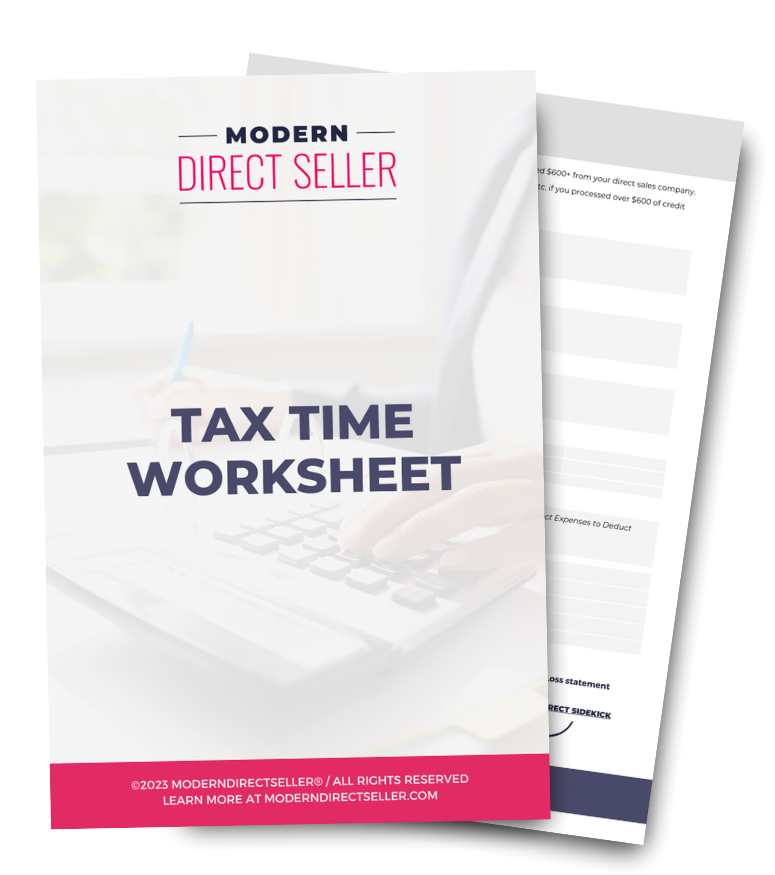Organize Your Direct Sales Finances and Prepare for Taxes
The fine-print: This post contains affiliate links, which means that if you click on one of the product links and make a purchase I’ll receive a small commission at no additional expense to you. See the full affiliate disclosure in the footer for more info.
Disclaimer: Before we start let me say that I am not a lawyer or accountant. As such I cannot guarantee the accuracy of the information provided. I will be sharing with you information about how we organized our business finances when we were running a direct sales business. We hope that it will help you get started. None of this information should be taken as legal or tax advice. You should consult a professional lawyer or accountant to understand your tax and legal obligations based on your specific situation.
Free Tax Time Worksheet!

You started your business
Congratulations! You have decided to get started in direct sales! That officially makes you a business owner! It is such an exciting time! Being a business owner has many advantages hourly or salary employees do not enjoy. For example, a portion of your cell phone and internet bills (things you would be paying for whether you have a business or not) are now business expenses. These expenses will offset the income you make from your business. You may also be eligible to take a home office deduction if you have dedicated working space or inventory storage areas in your home. All of these help lower your tax burden.
To fully get these benefits of being a business owner it is important to get your direct sales finances organized. Below we’ll share the things we’ve learned in our entrepreneurial journey and how we organized and kept track of our business finances and prepared for tax season when we were running a direct sales business.
Separate Your Business and Personal Accounts
We list this first because it makes everything else so much easier! Keeping track of your business expenses is much simpler if you use separate bank accounts for business and personal use. Even if you don’t decide to get an actual business bank account at this time, you can still use a separate personal bank account exclusively for business activities. We have a personal checking account we use for personal deposits and expenses and a separate business checking account for business deposits and expenses. Do the same thing with your credit cards also. Use one for personal expenses and one for business. It is so much easier to keep track of your business income and expenses if those transactions are not intermixed with all of your personal transactions.
Keep Track of Your Income and Expenses
Preparing for tax time will be easier if you keep track of your income and expenses throughout the year. We recommend doing this monthly. When we first started we used a simple Income and Expense tracker. Eventually, as your business grows you’ll want to setup systems to save you time and make tracking finances easier. Direct Sidekick makes tracking your income, expenses and inventory easier than ever! It also easily generates profit and loss reports to help you understand how your business is performing and prepare for taxes. Direct Sidekick is tailored specifically to direct sellers to help save you time, so you can focus on growing your business. Try it today!
Record Your Mileage
The IRS has a mileage allowance (70 cents per mile for 2025) for business owners. Essentially you get to deduct from your business income the rate above per business mile you drive. Depending on how much driving you do for business this could be a big savings. In order to take the deduction you have to keep a mileage log. The Income and Expense Tracker mentioned above has a tab to manually track your mileage. This works great if you aren’t doing too much driving for business. If you do a lot of driving you may want to consider TripLog to help you automatically track and categorize your miles.
Sales tax
Your parent company should be charging, collecting and sending sales tax to the proper agencies. You do not need to keep track of sales tax or send any money to your local tax agency. When you buy product to keep as inventory or sell at vendor events, you will be paying sales tax when you make the initial purchase. When you sell your inventory you should charge your customers sales tax to reimburse yourself for the sales tax you paid when you purchased the inventory.
Preparing for taxes
Taxes are a scary thing for some people. However, if you keep your direct sales finances organized throughout the year, filing taxes becomes a lot less intimidating. Below is the list we use at tax time to prepare for filing. If you’d like a condensed version of this info in a worksheet format, enter your name and email address below and we’ll send you a copy!
Free Tax Time Worksheet!

You will receive a 1099-NEC from your direct sales company if they pay you more than $600 during the year. If you earned less than $600 you will still need to report it as income on your tax return, but you will not get a 1099-NEC. If you earned any incentive trips and prizes with your company the amount on your 1099-NEC will be higher than the commissions and bonuses you earned. This is because the value of any incentive trips is considered income and will be reported on your 1099-NEC. The 1099-NEC form is mailed by January 31st from your direct sales company.
2) Gather your 1099-K forms
1099-K forms are sent from payment processors like Square or PayPal if you have over $2,500 in sales (this will soon be changing to just $600 in sales). They are also mailed by January 31st.
3) Generate a profit and loss statement
A profit and loss statement (or P&L) sounds like a fancy form, but it is really quite simple. The top of the form has all your income and the bottom has all your expenses. Then you subtract your expenses from your income to figure out your profit or loss. Our Income and Expense Tracker helps you make a profit and loss statement and categorize your expenses to help with tax filing. Or if you are using accounting software like Direct Sidekick, you will be able to generate a P&L using the Reports function in the software.
4) Calculate your end of year inventory
You are required to report the acquisition cost (amount you paid) of your inventory for taxes. This can end up being tricky to figure out for a lot of direct sellers because the cost of your inventory likely fluctuates. Some inventory you purchase at a discount off the retail price. And some you probably get as hostess rewards for free or a different discounted amount. Then some items are even gifted to you as a perk from your company. How are you supposed to know how much you paid for the inventory you have left at the end of the year? When we held inventory we would calculate the cost of our inventory by first determining what the retail value is of the inventory we had left at the end of the year. Then we’d multiply that by the average percentage discount we paid for product. Between the free, discounted and regular price items we would keep on-hand for vendor events and local in-person sales it averaged out to paying about 20% of the retail price for our inventory. For example, if the retail value of our inventory was $1,000 the acquisition cost of that inventory was estimated to be $200 ($1000 * 0.20 = $200).
Tip:
Maybe you only have one or a few products you sell and keep on hand. And maybe the cost of the product is consistent every time you purchase it. If this is the case, you may know exactly how much you paid for your inventory and can report that amount. In our case there was a catalog of hundreds of items and the cost of the items varied so we used this average cost method. Whatever method you use to determine the cost of your inventory, make sure you are consistent and continue to use that method going forward.
5) Fill out your mileage log
Finish filling out that mileage log you were keeping throughout the year so you know how many business miles you drove last year. If you are using software like TripLog to automatically track your miles you should be able to download a summary report that will show you how many personal and business miles you drove during the year.
6) Gather your home office expenses
To be eligible for the home office deduction at least one of the following must apply:
- You exclusively and regularly use part of your home as your principal place of business
- You exclusively and regularly use part of your home as a place where you meet customers
- You use part of your home on a regular basis for storing inventory or product samples
If you are eligible for the deduction the expenses you will need to gather are:
- Direct expenses – These are expenses exclusively for the home office and are fully deductible. Examples include things like repairs and maintenance only in the office (fixing a light, etc.)
- Indirect expenses – These are expenses that apply to the whole home and not just the home office. You will only be able to deduct a portion of these expenses. Examples include:
- Rent (if you do not own your home)
- Mortgage interest and property taxes (if you do own your home)
- Utilities (gas, electric, etc)
- Insurance
- Home maintenance expenses for the entire home (pest control, cleaning fees, etc.)
The amount you get to deduct on indirect expenses is calculated based on the percentage of your home that is used for your home office. So if your home is 1000 square feet and your office is 50 square feet and you use 50 square feet for storing inventory, the total square footage used for your home office is 100 square feet. The percentage of indirect expenses you will be able to deduct is 10% (100 sq ft / 1000 sq ft = 10%).
7) File your taxes
Most direct sellers run their business as a sole proprietor. By default, once you have any income from business activities according to the IRS you are a sole proprietor. Your business income and expenses will get reported on Schedule C and your profit or loss will roll up to your Form 1040. Your profits from the business will be subject to self employment tax so it is important to set aside money throughout the year to cover those taxes. The amount you need to save will vary by state but a typical recommendation is to save 25% of your profit to cover taxes.
Remember those 1099-NEC and 1099-K forms we talked about? Your business income should add up to the amounts reported on these forms or more. The IRS gets a copy of these forms so they know your business generated at least that much income. If you report a lower amount the IRS will likely reach out to you with an inquiry to figure out why. No one likes the IRS getting all up in their business so make sure to report your income accurately!
For a while we did our own taxes using TurboTax Home and Business. It walks you through a lot of simple questions and fills out all the necessary tax forms for you based on your responses. For anyone that wants to file taxes themselves I highly recommend giving TurboTax a try. Now that our business has evolved, grown and become more complex we outsource tax preparation to an accountant.
Do you have any other tips or recommendations? Let us know in the comments below!








Do you still recommend directsidekick?
Yes we do!
If a direct sales company requires a minimum purchase in order to earn commissions, is that considered a business expense, and how would it be categorized?
Any product you are purchasing and using for business purposes (to sell or for demonstration or marketing purposes, etc.) would be a business expense. If you are purchasing it and using it yourself then that wouldn’t be a business expense. If you are unsure or have questions, please consult your accountant as they will be able to advise you for your specific situation.
As a direct seller, I’m wondering if I went out of town for the weekend with friends and we all participated in a workshop that WE set up (not the company), could that whole weekend be written off as a business expense?
Definitely consult your CPA or tax advisor to see what they say for your specific situation, since I am not a professional in this area. In general though, I would say yes if it is a business trip and you’re talking about business and working then that at a minimum the business portion of the trip is a business expense. But if your trip is a week long and only 1 day of that is business and the other 6 are vacation going on excursions and what not, then only the business portion of the trip (flight, hotel, food and other biz expenses for the 1 day of business, etc.) would be business expenses. Everything else would be personal expenses. That’s my understanding, but definitely check with your tax professional to make sure.
When I order inventory, do I include the total of the invoice or the total of the inventory minus the tax and shipping, as my expense since they collect the tax and shipping?
Then, they send me a deposit for the % discount that I should make – I use that as income, correct. And when I sell it, that is also considered income?
The real question I have is – how do I record tax and shipping I paid, because if I don’t pass that on to the customer because I do a free shipping day or a promo – how do I record that?
Hi Jaclyn – When ordering inventory I would put the total invoice amount including tax and shipping in the COGS (Cost of Goods Sold) expense category. Then when you make a sale the total transaction amount including any tax or shipping you collect will show up in the income part of your profit & loss statement (or Income & Expense tracker if you are using that). Your parent company will charge you tax when you buy inventory and remit that tax to the proper government agency. Then when you charge your customer tax you are essentially reimbursing yourself for the tax you paid and that’s just income to you. If you did free shipping for a customer that would just be less income you get for the order. There wouldn’t be anything special to record. So in simpler terms, any money going out gets recorded as expenses and any money coming in gets recorded as income.
As always I like to qualify this with I’m not a tax professional or accountant. This is just information provided based on our experience in direct sales. If you have questions on your specific situation please consult a tax professional.
With my direct sales company, we pay full price + shipping + tax upfront. The company then direct-ships the product to my client. We receive sales commission every two weeks. Are the shipping and tax costs collected, and sent to the company, a tax deduction?
Any business related expenses would offset your income to lower the overall profit of your business. You pay taxes based on the amount of profit your business makes so those expenses will lower your tax burden. Product, shipping and tax costs are all directly related to you making sales so they are business expenses. This is my understanding, but I’m not a tax professional. I always recommend you work with an accountant or other tax professional to get advice based on your specific situation.
Hi Jeremy! You refer to the 1099-MISC (received from your direct sales company) and 1099-K (if you had sales over a certain amount from Square or the equivalent). My direct sales company issued a 1099-MISC and a 1099-NEC. The 1099-MISC only has one thing on it, Box 7, which specifically states “Payer made direct sales of $5,000 or more of consumer products to a buyer (recipient) for resale”. I take that to mean that they sold me $5000 or more in product at my cost. Is that correct? I do not read that as being income I read it as being what the sold to me. I am fairly new and I did not earn anywhere near that amount. The 1099-NEC shows the amount of nonemployee compensation, which I take that to be commissions they paid me, Designer Dollars earned and any other incentive/prize i may have received. Is that correct?
Hi Bobbi – It looks like this has changed for 2020. According to this article on the TurboTax site you’ll get a 1099-NEC that will have your income (commission, overrides, incentives, prizes, etc.) and then the 1099-MISC will have an X in box 7 to indicate you made over $5,000 in direct sales. I’m not sure if this would be how much product/inventory you purchased from the company, or how much you sold through the company site, or maybe both. I’ll have to look into that some more. So it sounds like they did what they’re supposed to per the rules in 2020. I’ll have to update my blog post. Thanks for bringing it up!
Thank you for your amazingly quick response!! Based on the language that appears in box 7 it is product sold directly to me.
I am confused about inventory. How do you come up with 20% of the retail value? I am a UBAM indep. consultant. Thank you!! (this tax stuff is driving me crazy!)
Hi Sheryl – That 20% of retail is just an example. As I mentioned in the post you are really supposed to be reporting the acquisition cost of your inventory, but it likely isn’t easy (or possible) to figure out what the actual cost was of the inventory you ended up with at the the end of year. This is because the cost of items will fluctuate (sometimes a discount off the retail price like a hostess reward, sometimes free, sometimes full retail price, etc.). Because we didn’t know the actual cost we paid for the inventory left we would find out the retail price of our inventory on hand (using the Inventory Tracker when Becky was with UBAM) then multiply it by the percentage discount we estimated to pay on average to acquire inventory. So in the example in the blog post I’m assuming on average we are paying 20% of the retail price to get our inventory. This is just an example and your actual percentage estimate may be different. I’m not a tax professional so definitely check with yours if you’re concerned about it and want to make sure you’re doing it right.
Thanks, Jeremy! Another question about Income. In your expense tracker you show 1099-MISC Income, General Income, etc. But on the IRS form it asks for “Gross Receipts or Sales”. I don’t see anywhere it asks for the 1099-MISC. Are these different or the same thing just in different words?
The gross receipts or sales is your total income. I have a couple different income categories in the income and expense tracker to help match things up at tax time. For example the 1099-MISC category is used for all income that would be reported to you on a 1099-MISC. If you keep that income separate on the income and expense tracker it is easy to verify the amount reported on your 1099-MISC from your company matches the actual income your recorded for that category. There is a tab in the income and expense tracker with definitions for the different categories. Your gross receipts or sales would be the sum of all the income from those categories (your total income calculated at the bottom of the income table).
Thank you, Jeremy!
Hi there! sooo what do we do about inventory that we have from last year and didn’t report it 🙁 I didn’t do all of this last year when I actually started in direct sales. Thanks so much!
Hey Ashley – First off, as always I’d recommend you consult your tax professional/CPA and see what they say. Technically I think you’re supposed to go back and update your previous year taxes to put in the inventory so it’s accurate, but that’s a bit of a hassle. You could just report where you’re at with inventory in the next tax filing. It’s up to you and what you’re comfortable with.
This may be a “duh” question, but in filling out my taxes as a direct sales consultant, do you know if I put MY home address as the business address, or the address of the parent company? (All products are ordered online & then shipped from parent company)
I have searched online but can’t find anything definitive. Thanks in advance for any help!
Hi Lauren – These are your taxes you’re filing so you’ll put your address as the business address.
Is the inventory amount a deduction? And if i have borrowed consignment. I am not planning on returning i treat it as mine to sell. Do i add that in? Taxes confuse me and i do not want to mess up. Lol
Hi Christina – The amount you pay to acquire your inventory is an expense that would show up under cost of goods sold. You will also need to take inventory at the end of the year and that inventory you have on hand is also reported in the cost of goods sold section. Consignment is essentially loaned to you so that is not an expense. It becomes an expense when you reconcile the consignment and actually make the payment for it. I’m not an accountant, but this is my understanding. If you want to be 100% sure you are doing things correctly I’d recommend you hire an accountant so they can advise you on your specific situation. Hope that helps!
How would you factor charitable contributions on your taxes? If you gave away books as a donation, you wouldn’t have a contribution form from the recipient(s)
Hi Amy – Businesses don’t get a charitable contribution deduction like individuals. If you are providing items to get your name out there and to help with getting new customers you could probably deduct the cost of the items you are providing as an advertising expense.
Does Consignment Inventory count as regular inventory? I just took out a consignment this year ( 2020 ) but I do have inventory left over from last year. do I only add up the inventory from 2019? ( Sorry new consultant here )
Hi Karri – Is your question related to 2019 taxes? If so you should only be counting whatever your ending inventory was as of the end of 2019. Any new inventory received in 2020 would be factored in to your 2020 finances. We always treated all our inventory the same whether it was purchased normally or obtained through consignment.
Ok! Now I understand! Thank you so much!
Do you have any tax tips when it comes to selling discounted books or free books awarded to me at full price for customers?
Hey Katie – I would charge sales tax on those books just like you do on your other books. Unless you are segregating those books from your others you wouldn’t be able to tell which ones you got for free/discount or which ones you paid regular price for anyway.
What is the business code for A Schedule C that you list for Usborne? It’s a 6 digit code.
We used 999999.